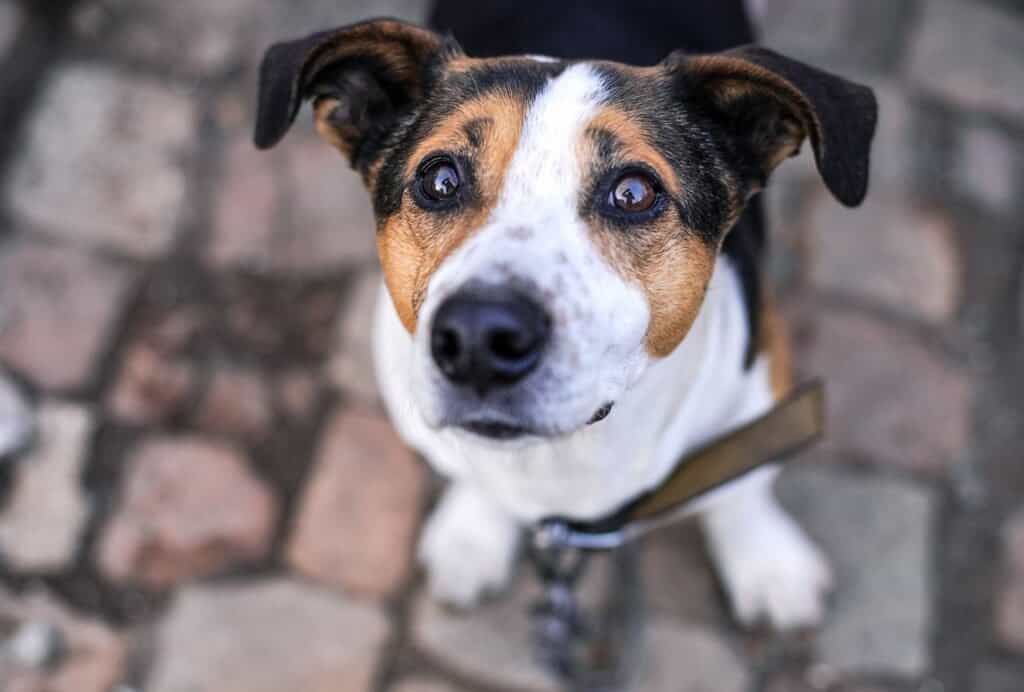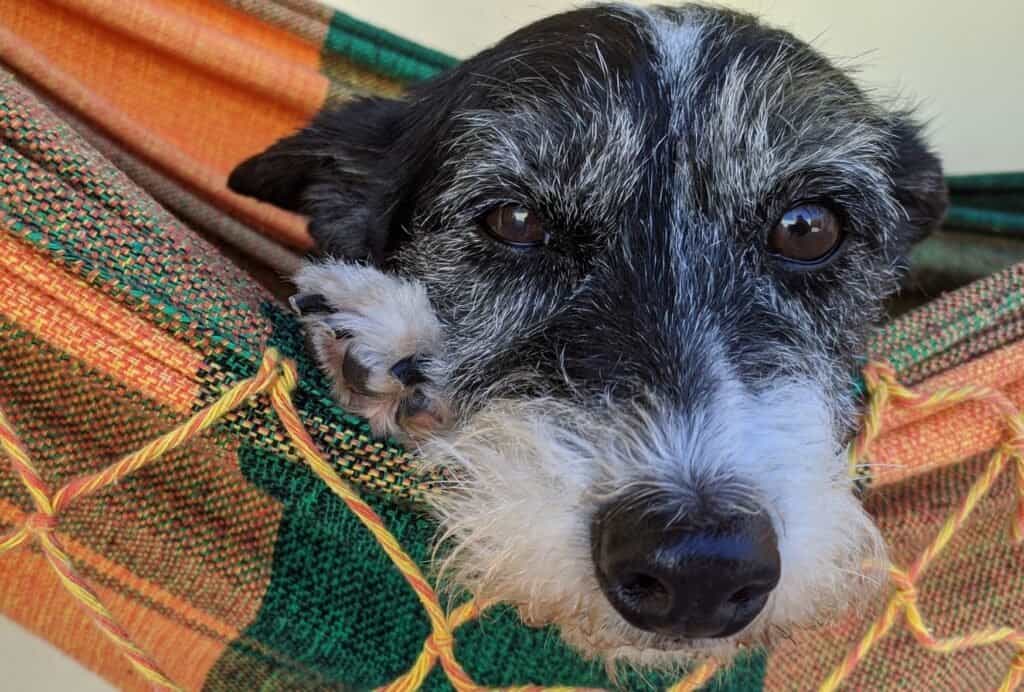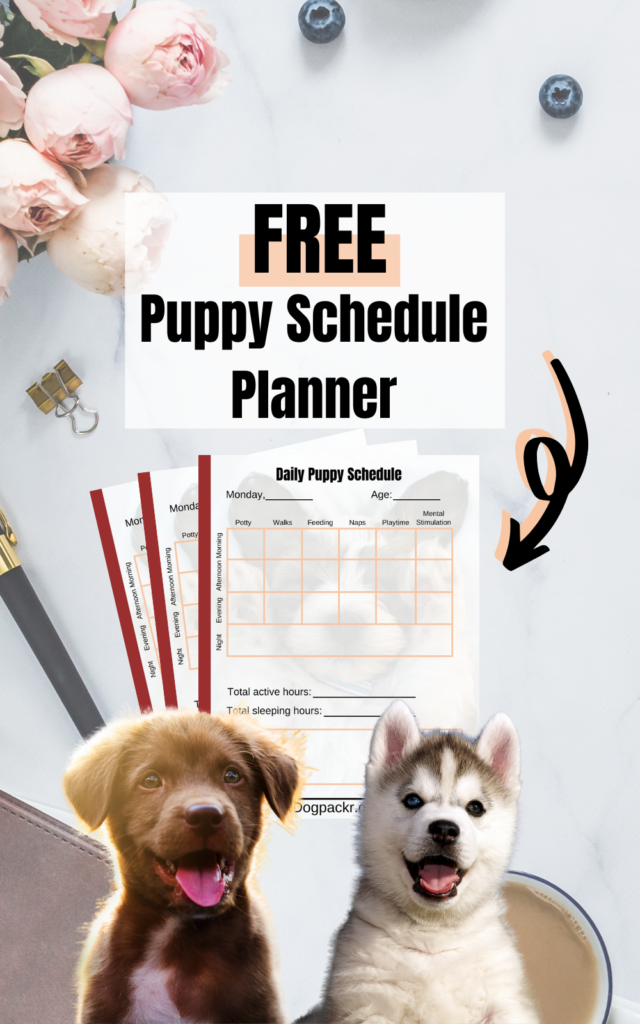
Does your dog stick to you so tightly that his fur might as well be Velcro?
Well, there’s the reason why clingy dogs are also called Velcro dogs.
Some of our furry friends seem to love their owners so much that they literally can’t let them out of sight for even a second.
My Mini Poodle Baloo also used to be a super Velcro dog. It’s become a little better as he’s grown older.
He’s still incredibly focused on me and loves to be close to me. But he can also easily sleep throughout the whole morning without even once standing up to see what I’m doing. So, he’s still clingy but it’s now bearable.
If that sounds familiar, stick around. In this article, I’ll show you why some dogs are so clingy—and how to tone it down.
Here’s the summary: Clingy dogs, also called Velcro dogs, are pups who love to follow us everywhere and don’t let us out of their sight. This usually happens if your dog is bored, stressed, anxious or simply aging. A change in routine or your emotions are also common reasons.
Table of Contents
Why Is My Dog So Clingy?
Does your dog follow you around everywhere? Does it seem like he needs to always be touching you, or at least see you?
There are a few reasons why your dog might be so clingy. But first, let’s go over what “clingy” really means here.
What Does It Mean to Have a Velcro Dog?
If you have a Velcro dog, that basically means your dog follows you around everywhere and wants to be as close to you as possible at all times.

There are a variety of reasons some dogs are—or become—Velcro dogs. Sometimes it just has to do with the breed. Many dogs are bred to naturally want to be as close to their owners as possible.
At other times, dogs become clingy Velcro dogs because of our own behavior towards them. Rewarding attention-seeking behavior like clinging or constant pawing by giving them attention can encourage dogs to become clingy.
Having a Velcro dog might seem cute at first. Is there anything sweeter than your dog just wanting to be close to you?
But those who have Velcro dogs know that it’s no picnic. It can get annoying quickly, especially when your dog is constantly underfoot!
Why Does My Dog Follow Me Everywhere?
It might seem strange to us that our dogs follow us from one room to another, even if we’re only getting up for a second and then coming right back. So why does he follow you around everywhere?
Fundamentally, dogs are pack animals. They are very social creatures and want to stick close to their pack. In this case, the pack is you—their human.
If you get your dog while he’s still very young, he might imprint on you, and see you as his mother.
And, like Velcro dogs, you might be unwittingly rewarding this type of behavior by acknowledging him while he’s following you. Even giving him a quick scratch behind the ears tells him that following you around is welcome!
And I’ve totally been guilty of that too. Isn’t it just so cute when your pup is so interested in literally everything you do? Just irresistible…

What Does It Mean When Your Dog Won’t Leave Your Side?
If you find yourself attached at the hip to your dog, it could be because of the breed, or because you’ve been unintentionally encouraging the behavior.
If your dog has always been like this, there are ways to help train him out of it. But if your dog is acting clingy when he never has before, that’s a sign something might be wrong.
Why Is My Dog Suddenly Clingy?
Let’s look at why your dog might be suddenly clingy.
A sudden change of behavior in dogs should always be observed closely, as it can indicate that something’s wrong.
Change in Routine
By nature, dogs are creatures of habit. Setting up a good, reliable routine for your dog is one of the best ways to keep him happy and healthy.
But if there’s a change in his routine, that can mess up his balance. Maybe you started a new job and work evenings instead of mornings. Or maybe you’re moving—or just finished—and it’s confusing your dog.
Whatever the change in routine is, some dogs struggle with change more than others. If your dog is suddenly acting clingy and refuses to leave your side, consider any major changes going on in his life.
Significant changes in your dog’s environment might also lead to depression. Keep an eye out for any other symptoms your dog might be showing.
A good routine is also one key element for a relaxed dog. Make sure to download my free schedule planner to make it so much easier to set up and track!
Aging or Illness
As they get older, some dogs might become more clingy. This usually has to do with some of their senses deteriorating, like vision or hearing.
While many dogs who lose their senses of vision or hearing can bounce back quickly and continue living a fulfilling life, some dogs have more difficulty with the change. This is especially true during the early stages of aging.
As his hearing and vision start to go, he might stick by you more closely, where he feels safe. The same is true for illness. In his uncertainty, your dog will want to stick by your side.

Boredom
Boredom is one of the biggest culprits for unwanted behavior. If your dog is following you around all the time, it could very well be because he’s bored.
If your dog isn’t getting enough physical and mental stimulation, he might stay glued to your side because there’s nothing else for him to do to occupy himself.
In case boredom is the reason for his clinginess, here are a few articles for you:
- My dog is bored, what can I do? Feat. boredom busters
- Is my dog bored or tired? Or maybe just lazy?
- 21 fun things to do with your dog at home
Mental stimulation can also be a wonderful training tool if used correctly. Check out Braintrainingfordogs to learn how to train your dog to be the best dog he can be by using mental stimulation! Or have a look at Dogpackr’s review first to see if it’s a fit for you and your dog!

Anxiety
If your dog is feeling anxious, he might suddenly become clingier.
Sometimes a dog’s anxiety can stem from changes in his environment. If something is stressing him out, he might try to stay closer to you, where he feels safe.
But sometimes your dog’s anxiety can become very severe. Separation anxiety is a difficult behavioral problem to deal with for both you and your dog.
A dog with separation anxiety has a very hard time being away from his owner. It goes beyond normal “I’m missing you” behavior when you’re gone.
Signs of separation anxiety include barking and howling, going potty inside the house, chewing and destroying furniture, clothing, and other items, and attempting to escape.
Clinginess is another sign of separation anxiety. Your dog doesn’t want you to leave because of how anxious it makes him. This can be hard on both you and your dog. Luckily, there are many ways to treat separation anxiety depending on how severe it is.
They Sense We’re Stressed
Dogs are very emotional and intuitive animals and can pick up on when we’re stressed.
If you’re feeling stressed out, your dog might act clingy because you’re stressing him out.
In case your dog is suddenly clingy, ask yourself how you’ve been feeling and behaving recently. If there’s something in your life that’s stressing you, your dog is probably picking up on that and being clingy for that reason.

How to Make Your Dog Less Clingy
Understanding why our dog is acting clingy is the first step. Now it’s time to talk about how to make them less clingy.
Establish a Daily Routine
As we’ve already said, dogs thrive if they have a routine. If your dog is acting clingy, a change in his routine might be the culprit for his clinginess, or he’s never had a dependable routine in the first place.
For this reason, it’s important to establish a routine for your dog. This will allow your dog to know what to expect and when.
Getting rid of that uncertainty will help your dog feel more confident about what the day will bring, but will also stop him from acting like he’s surgically attached at your hip.
Ignore Attention Seeking Behavior
A lot of a dog’s clinginess might come from us unintentionally rewarding it. When your dog does something to get your attention, you’re rewarding him even by just acknowledging him.
This might encourage him to be clingy since he knows attention-seeking behavior gets him what he wants.
It’ll take a lot of time and patience, but the best way to stop it is by ignoring the behavior. Remember, even negative attention is attention, and that’s all your dog wants. By ignoring him, over time he’ll learn that this is the wrong way to go about getting you to notice him.
Confirm that He Gets Enough Physical and Mental Stimulation
Since boredom is one of the biggest reasons for behavioral problems in dogs, it’s important to make sure that your dog is getting enough stimulation during the day.
Taking him for walks or jogs and making sure he gets enough playtime are great ways to make sure he’s getting enough exercise.
You can also sign him up for dog sports. Things like agility and flyball are awesome ways for both you and your dog to bond, build confidence, and get rid of excess energy.
Make sure you’re working his brain too! There are so many great brain games for dogs that will be fun for both of you.
Ask Your Vet
If your dog is suddenly acting clingy, you might want to schedule a visit to your vet. Since dogs can become clingier with aging and illness, you’ll want to rule out that anything is seriously wrong with your dog.
If your dog is sick or losing his senses because of aging, your vet will help set you up with a treatment plan. And if it’s not a medical problem, then you at least have some peace of mind and can work towards solutions for whatever the problem actually is.
Also make sure to have look at my special post about more tips on how to save on your vet bills!
Conclusion
Dogs can be clingy for many reasons. Some breeds are naturally clingy and more dependent than others. Sometimes a change in a dog’s life can make them clingy. And sometimes dogs who struggle with separation anxiety can be very clingy, as being away from their owners is hard on them.
Whatever the reason, while it might seem cute at first, clinginess can quickly become an annoying, unwanted behavior. Make sure that you and your dog have a routine. Also make sure that he’s getting enough physical and mental stimulation, and check in with your vet if you think it might be a medical problem.
Over time, your dog will start to gain the confidence he needs to be less clingy.
P.s.: Don’t forget to check out Braintraining4dogs if you want to take your dog training game to the next level. It offers a 60-day money back guarantee, so you have nothing to lose.

*Disclosure: This post may contain affiliate links, meaning, I get a commission if you decide to make a purchase through one of my links, at no cost to you.

